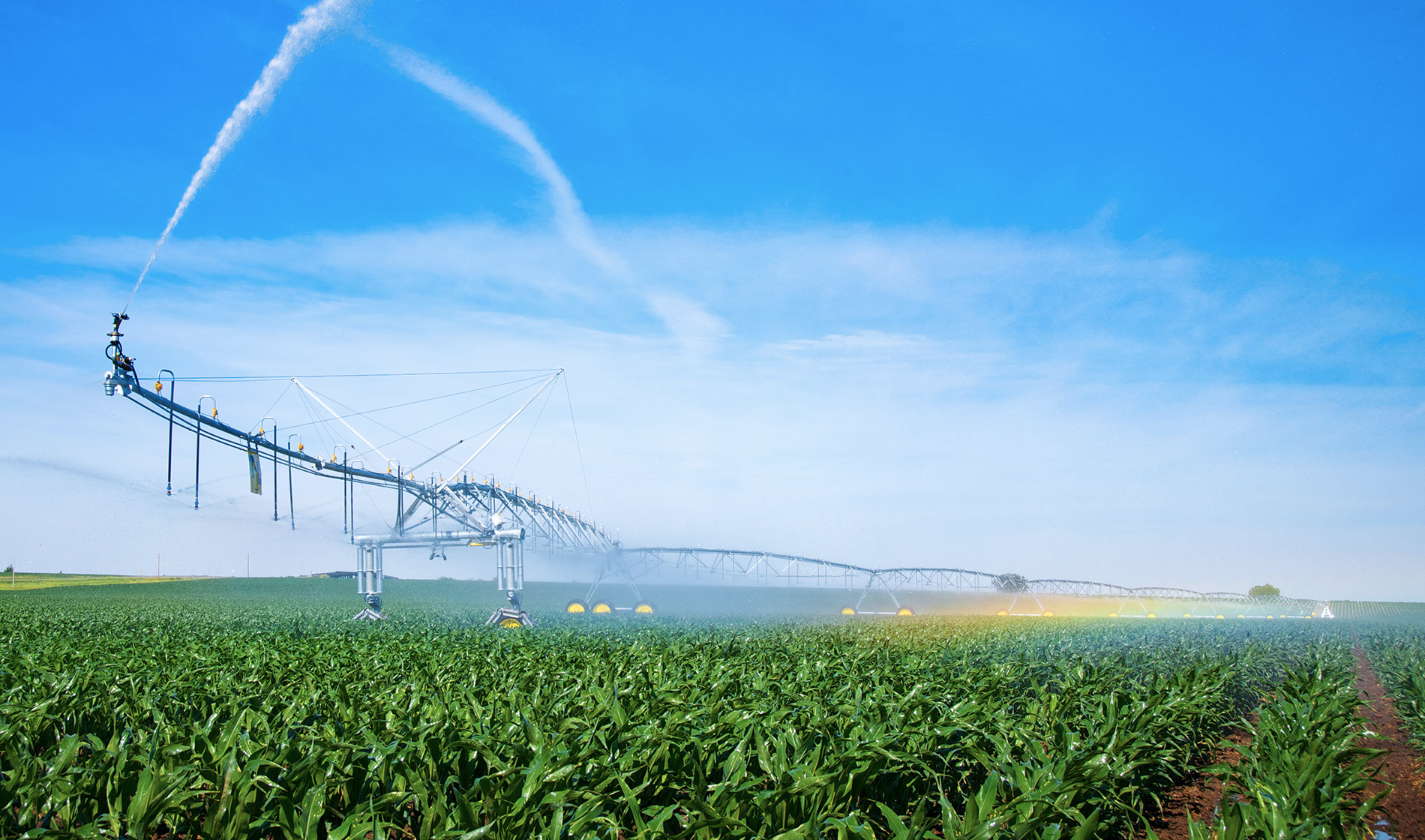Testimonials
 | Plains, Kansas |
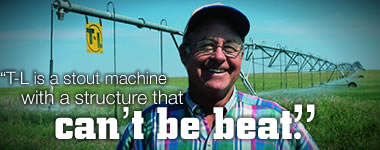 Typical of many farmers in his region, the ground that Warren Fox, Plains, Kansas, farms is sandy, loamy soil on rolling hills. So, when he began irrigating he didn’t even consider flood irrigation. As he notes, “Even if flood irrigation would have worked, which it couldn’t due to the expense of leveling alone, it just wasn’t efficient enough and I didn’t have the necessary labor.”
Warren Fox grows corn, soybeans and wheat. Fox also uses T-L pivots to irrigate grasses for hay to be fed to his cowherd. This eight-year-old field of WW Spar and Ironmaster is still yielding well despite its age. Fox takes off two cuttings after grazing it until June each year with his cows and spring calves by side. He irrigates two such grass circles from one well, with the pivots making a round every two days.
Now he has 30 center pivot systems on the move during the growing season. Fox had experience with irrigation systems from half a dozen manufacturers over the years. Twelve of his present pivots are T-L Irrigation Co. units, with more to follow, he predicts.
He bought his first T-L in 1988. He’d talked with his neighbors using T-L systems who told him they were getting along pretty well with them.
“I was looking for simplicity,” Fox points out, “In short, a pivot that would keep on making circles without a lot of repairs and expense. I also liked T-L’s continuous movement, no start-stop like an electric system that can make an uneven water pattern. What I’ve found is that T-L is a stout machine with a structure that can’t be beat.”
Fox likens the continual starting and stopping of electric systems to using an impact wrench on the unit’s parts since it starts at 100% speed and shuts off the same way. Electrics are just not the low maintenance machines that T-L’s are, he believes, based on experience.
“If I could take a vacation with all the money I’ve spent on T-L parts and labor over the years it would be pretty short”, Fox smiles. During the thirteen years he’s been using his first T-L system the only repairs it has needed have been one gearbox and a couple of 3/8 inch bolts in the driveline.
According to Fox, “That system is as dependable as the first day I bought it. Look at the storage bins in my shop and you’ll see only a handful of T-L parts, and I have had bins full of electrical pivot parts.” He adds, “I almost always check my T-L systems last every morning, because I know they will be running and won’t require maintenance. I don’t find that with my electric machines.”
It’s difficult to calculate the true cost of a repair shutdown, Fox says, but he thinks that crop losses due to three or four shutdowns a season while the unit sits a half-day or more, can quickly add up to affect his bottom line.
On the other hand, Tom Wright IV of Lakin, Kansas, started with flood irrigation. His methods evolved from ditch, to pipe, to surge valves over the years, yet he still wasn’t satisfied. “I was looking for more efficiency and labor savings,” he recalls, explaining why nine quarter-mile and two half-mile systems have replaced flood irrigation on his land.
“The 60 to 80 acres we could typically handle under flood irrigation expanded to 180 acres under pivots and meanwhile increase our yields.” Wright continues, “Pivot irrigation is also a lot easier on the body. Since I quit flood irrigating I don’t have back problems.”
In contrast to Fox, all of Wright’s pivots are T-L units. He says, “I decided in the beginning to go with the hydraulic T-Ls and I haven’t regretted it. In eight years the total of downtime with our 11 units has been only five or six hours. I’ve liked the T-L strength and reliability,” he continues, “since they seem to be built good and hold together well. I also like being able to keep everything as safe as I can for my employees and me. I wouldn’t want either of us working on an electric system.”
Efficiency is also important to Wright since his wells range in capacity from barely 300 gallons a minute to 450 gallons a minute. He’s also noticed none of the “spoking” effect typical of the continual starting and stopping of a neighbor’s electric pivots. This can leave portions of a crop wilted immediately after the pivot has moved on.
The start stop factor no doubt contributes to increased wear, too, he reasons. As for his T-L dealer service, Wright says it’s gone from good to even better. And, he likes the full service offered that enables him to deal with just one firm for everything from irrigation well to pipe to sprinkler.
Summing up his experience with T-L pivot systems, Wright says, “You can buy cheaper systems, but you get what you pay for. I’m also a Pioneer seed salesman and here also you can buy cheaper seed elsewhere, but you can’t count on the best yields with it.”
Typical of many farmers in his region, the ground that Warren Fox, Plains, Kansas, farms is sandy, loamy soil on rolling hills. So, when he began irrigating he didn’t even consider flood irrigation. As he notes, “Even if flood irrigation would have worked, which it couldn’t due to the expense of leveling alone, it just wasn’t efficient enough and I didn’t have the necessary labor.”
Warren Fox grows corn, soybeans and wheat. Fox also uses T-L pivots to irrigate grasses for hay to be fed to his cowherd. This eight-year-old field of WW Spar and Ironmaster is still yielding well despite its age. Fox takes off two cuttings after grazing it until June each year with his cows and spring calves by side. He irrigates two such grass circles from one well, with the pivots making a round every two days.
Now he has 30 center pivot systems on the move during the growing season. Fox had experience with irrigation systems from half a dozen manufacturers over the years. Twelve of his present pivots are T-L Irrigation Co. units, with more to follow, he predicts.
He bought his first T-L in 1988. He’d talked with his neighbors using T-L systems who told him they were getting along pretty well with them.
“I was looking for simplicity,” Fox points out, “In short, a pivot that would keep on making circles without a lot of repairs and expense. I also liked T-L’s continuous movement, no start-stop like an electric system that can make an uneven water pattern. What I’ve found is that T-L is a stout machine with a structure that can’t be beat.”
Fox likens the continual starting and stopping of electric systems to using an impact wrench on the unit’s parts since it starts at 100% speed and shuts off the same way. Electrics are just not the low maintenance machines that T-L’s are, he believes, based on experience.
“If I could take a vacation with all the money I’ve spent on T-L parts and labor over the years it would be pretty short”, Fox smiles. During the thirteen years he’s been using his first T-L system the only repairs it has needed have been one gearbox and a couple of 3/8 inch bolts in the driveline.
According to Fox, “That system is as dependable as the first day I bought it. Look at the storage bins in my shop and you’ll see only a handful of T-L parts, and I have had bins full of electrical pivot parts.” He adds, “I almost always check my T-L systems last every morning, because I know they will be running and won’t require maintenance. I don’t find that with my electric machines.”
It’s difficult to calculate the true cost of a repair shutdown, Fox says, but he thinks that crop losses due to three or four shutdowns a season while the unit sits a half-day or more, can quickly add up to affect his bottom line.
On the other hand, Tom Wright IV of Lakin, Kansas, started with flood irrigation. His methods evolved from ditch, to pipe, to surge valves over the years, yet he still wasn’t satisfied. “I was looking for more efficiency and labor savings,” he recalls, explaining why nine quarter-mile and two half-mile systems have replaced flood irrigation on his land.
“The 60 to 80 acres we could typically handle under flood irrigation expanded to 180 acres under pivots and meanwhile increase our yields.” Wright continues, “Pivot irrigation is also a lot easier on the body. Since I quit flood irrigating I don’t have back problems.”
In contrast to Fox, all of Wright’s pivots are T-L units. He says, “I decided in the beginning to go with the hydraulic T-Ls and I haven’t regretted it. In eight years the total of downtime with our 11 units has been only five or six hours. I’ve liked the T-L strength and reliability,” he continues, “since they seem to be built good and hold together well. I also like being able to keep everything as safe as I can for my employees and me. I wouldn’t want either of us working on an electric system.”
Efficiency is also important to Wright since his wells range in capacity from barely 300 gallons a minute to 450 gallons a minute. He’s also noticed none of the “spoking” effect typical of the continual starting and stopping of a neighbor’s electric pivots. This can leave portions of a crop wilted immediately after the pivot has moved on.
The start stop factor no doubt contributes to increased wear, too, he reasons. As for his T-L dealer service, Wright says it’s gone from good to even better. And, he likes the full service offered that enables him to deal with just one firm for everything from irrigation well to pipe to sprinkler.
Summing up his experience with T-L pivot systems, Wright says, “You can buy cheaper systems, but you get what you pay for. I’m also a Pioneer seed salesman and here also you can buy cheaper seed elsewhere, but you can’t count on the best yields with it.” | Laverne, Oklahoma |
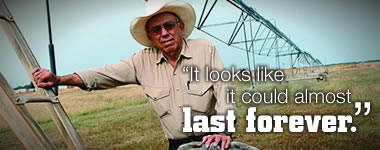 There’s one almost sure thing in Laverne, Oklahoma: The T-L center pivot just outside of town at the old refi nery clean-up project will be running–day and night, spring, summer, and fall, and most of the winter, too.
For the last five and a half years it’s been operating at least 85 percent of the time, according to Boog Evans, the contractor in charge of operating the unit. The system is just a shade more than halfway through a ten year cleanup program.
Evans figures in that limited period of time the heavily used T-L has been handling its sprinkling chores for more than 41,000 hours. At an average 175 gallons a minute, 430,301,000 gallons of water have flowed through its nozzles.
When the refinery closed down it was found that petroleum products were working their way closer and closer to the town’s wells. At first it was thought that water “cleaned” by bubbling air through it could be sent to the river via an old pipeline. The pipeline had become porous, however, and Plan B was to keep the water on site.
Pumps move water from wells dug around the perimeter of the old refinery to one of several “cleaning” buildings. From there the water goes to a holding basin from which the water is pumped to the adjacent T-L center pivot.
The average application rate on native grass seeded on former cropland is between 150 to 200 gallons a minute. A local farmer handles the hay harvest chores.
Like the famous battery bunny, the T-L system has just kept going and going and going, according to Evans. There have been only two exceptions over the years.
One is when Evans sees a forecast for a few days with below freezing temperatures. When that happens he pulls down the holding basin by increasing flow through the system before temporarily shutting it down.
The other exception was a tornado that tried its best to roll up the center pivot into a steel ball! Evans says, “The T-L dealer has always been only a phone call away.” In two weeks the dealer had the unit running again, and it gamely continued to apply water to the hayland, although with two fewer towers.
While it took a twister to do it, the only real trouble Evans has experienced with the T-L system came immediately after the storm. The jerking around and tumbling the pivot endured caused some hydraulic fluid leakage. However, after chasing down and stopping the leaks, he reports virtually no hydraulic fluid has been used for the past year and a half.
As for other repairs, the records show that only $1,501.23 has been spent. That figures out to just $273 a year or 3-1/2 cents an hour for a center pivot that’s come as close to continuous operation as just about any such unit in the country.
It’s actually been so reliable that Evans reports that he now schedules a single visit a week to check the gearboxes and tire pressures, even with mostly 24/7 operation.
“This T-L has been pretty well maintenance-free. It’s a great system,” he sums up. “How long will it last at the rate it’s being used? I don’t know–it looks like it could almost last forever.”
There’s one almost sure thing in Laverne, Oklahoma: The T-L center pivot just outside of town at the old refi nery clean-up project will be running–day and night, spring, summer, and fall, and most of the winter, too.
For the last five and a half years it’s been operating at least 85 percent of the time, according to Boog Evans, the contractor in charge of operating the unit. The system is just a shade more than halfway through a ten year cleanup program.
Evans figures in that limited period of time the heavily used T-L has been handling its sprinkling chores for more than 41,000 hours. At an average 175 gallons a minute, 430,301,000 gallons of water have flowed through its nozzles.
When the refinery closed down it was found that petroleum products were working their way closer and closer to the town’s wells. At first it was thought that water “cleaned” by bubbling air through it could be sent to the river via an old pipeline. The pipeline had become porous, however, and Plan B was to keep the water on site.
Pumps move water from wells dug around the perimeter of the old refinery to one of several “cleaning” buildings. From there the water goes to a holding basin from which the water is pumped to the adjacent T-L center pivot.
The average application rate on native grass seeded on former cropland is between 150 to 200 gallons a minute. A local farmer handles the hay harvest chores.
Like the famous battery bunny, the T-L system has just kept going and going and going, according to Evans. There have been only two exceptions over the years.
One is when Evans sees a forecast for a few days with below freezing temperatures. When that happens he pulls down the holding basin by increasing flow through the system before temporarily shutting it down.
The other exception was a tornado that tried its best to roll up the center pivot into a steel ball! Evans says, “The T-L dealer has always been only a phone call away.” In two weeks the dealer had the unit running again, and it gamely continued to apply water to the hayland, although with two fewer towers.
While it took a twister to do it, the only real trouble Evans has experienced with the T-L system came immediately after the storm. The jerking around and tumbling the pivot endured caused some hydraulic fluid leakage. However, after chasing down and stopping the leaks, he reports virtually no hydraulic fluid has been used for the past year and a half.
As for other repairs, the records show that only $1,501.23 has been spent. That figures out to just $273 a year or 3-1/2 cents an hour for a center pivot that’s come as close to continuous operation as just about any such unit in the country.
It’s actually been so reliable that Evans reports that he now schedules a single visit a week to check the gearboxes and tire pressures, even with mostly 24/7 operation.
“This T-L has been pretty well maintenance-free. It’s a great system,” he sums up. “How long will it last at the rate it’s being used? I don’t know–it looks like it could almost last forever.” | Beaver, Oklahoma |
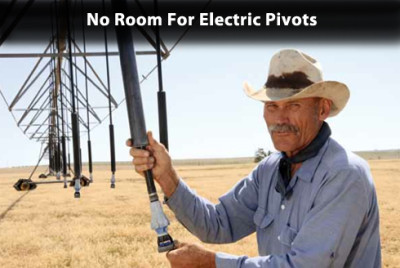 This Oklahoma rancher insists that one way or another, his only electric center pivot unit is leaving!
Steve Parker doesn’t have much use for the electric center pivot irrigation system he bought several years ago. And he means that both literally and figuratively.
“It’s been at least 15 years since I’ve even used it,” says Parker, who has since installed two T-L center pivot units on the cattle and wheat operation he owns south ofBeaver, Oklahoma. “Yet, every month, until I told them to just come out and remove the meter, I was having to pay a meter service charge.
“I think I’ve finally got it sold,” he relates. “But I’ll cut it up and build cattle pens out of the pipe if I have to. One way or the other, it’s leaving. I’ve had nothing but trouble with that one since the day I bought it.”
Irrigation is nothing new to Parker, however. For as long as he can remember, Parker has been moving irrigation pipe and dealing with temperamental systems. In fact, he says his father and grandfather drilled the first well in 1962 and began furrow irrigating corn and sorghum for silage. Even today, Parker says he still does some furrow irrigation in combination with a few side-roll lateral systems.
“I liked the idea of no electricity, because I understand hydraulics a whole lot better than I do 480-volt electricity.”
“Fortunately, I’ve since got acquainted with my dealer for T-L,” he adds. “I liked the idea of no electricity, because I understand hydraulics a whole lot better than I do 480-volt electricity.”
Although a lot of things have changed since Parker put in the first of his two T-L units — without any electricity needed at the control box — he says he still holds a preference for T-L pivots. Originally, he says, they were installed to help irrigate wheat, alfalfa and forage grown for a family owned dairy that once numbered up to 140 cows. Today, the dairy is gone, and so is the alfalfa.
However, cattle are still the focus on Parker’s ranch. It’s just that the herd that averages around 175 in number now consists of beef cattle.
“Wheat is the only cash crop I grow,” Parker says, relating that around 350 acres total are under some type of irrigation. “Otherwise, it’s all cattle related.”
In addition to the cow/calf herd that he maintains year around, Parker says he and his son, who works at the sale barn in Beaver, often buy what they call “put together cows”.
“Those are the old cull cows that come through the ring one or two at a time,” he explains. “We try to buy them pregnant so we can get at least one more calf off of them while speculating on the cows themselves.”
Unfortunately, Parker is still responding to one of the worst droughts in history. Just this past summer, he was forced to sell off more than 40 head of cows, bringing his herd down to around 115 animals.
Still, he insists it would have been worse had he not had a crop of cool-season grass under one of his T-L pivots. In addition, Parker is not one to over-graze a pasture of any kind. That includes the winter wheat he used for pasture this past winter.
“I’d open the gate and leave them on the wheat for four or five hours at a time and drive them off,” he says, noting that he also has about 120 acres of dryland wheat. “I can still remember when I was in grade school and not being able to see more than a few hundred yards because of blowing dust; and I don’t intend to let it happen again. Besides, if you manage it right, you can graze the wheat during the winter and still get a decent wheat crop. Of course, that wasn’t the case this year, with the drought. We were lucky to get any wheat at all.”
Of course, that’s another reason he has dreams of adding at least one or two more T-L units as replacements for the side-roll machines.
“Those lateral-move units are so inefficient they can barely pull their own weight when they’re filled with water,” he says. “In comparison the T-Ls not only save water, but they do a better job of putting it on than our electric pivot ever did. Because of the hydraulic drive, the motion is always steady, whereas the electric units continuously stop and start.
“Best of all, the T-L pivots require a lot less labor than either the side-roll systems or the electric units,” he concludes. “And at my age, I’m all for anything that takes less labor.”
This Oklahoma rancher insists that one way or another, his only electric center pivot unit is leaving!
Steve Parker doesn’t have much use for the electric center pivot irrigation system he bought several years ago. And he means that both literally and figuratively.
“It’s been at least 15 years since I’ve even used it,” says Parker, who has since installed two T-L center pivot units on the cattle and wheat operation he owns south ofBeaver, Oklahoma. “Yet, every month, until I told them to just come out and remove the meter, I was having to pay a meter service charge.
“I think I’ve finally got it sold,” he relates. “But I’ll cut it up and build cattle pens out of the pipe if I have to. One way or the other, it’s leaving. I’ve had nothing but trouble with that one since the day I bought it.”
Irrigation is nothing new to Parker, however. For as long as he can remember, Parker has been moving irrigation pipe and dealing with temperamental systems. In fact, he says his father and grandfather drilled the first well in 1962 and began furrow irrigating corn and sorghum for silage. Even today, Parker says he still does some furrow irrigation in combination with a few side-roll lateral systems.
“I liked the idea of no electricity, because I understand hydraulics a whole lot better than I do 480-volt electricity.”
“Fortunately, I’ve since got acquainted with my dealer for T-L,” he adds. “I liked the idea of no electricity, because I understand hydraulics a whole lot better than I do 480-volt electricity.”
Although a lot of things have changed since Parker put in the first of his two T-L units — without any electricity needed at the control box — he says he still holds a preference for T-L pivots. Originally, he says, they were installed to help irrigate wheat, alfalfa and forage grown for a family owned dairy that once numbered up to 140 cows. Today, the dairy is gone, and so is the alfalfa.
However, cattle are still the focus on Parker’s ranch. It’s just that the herd that averages around 175 in number now consists of beef cattle.
“Wheat is the only cash crop I grow,” Parker says, relating that around 350 acres total are under some type of irrigation. “Otherwise, it’s all cattle related.”
In addition to the cow/calf herd that he maintains year around, Parker says he and his son, who works at the sale barn in Beaver, often buy what they call “put together cows”.
“Those are the old cull cows that come through the ring one or two at a time,” he explains. “We try to buy them pregnant so we can get at least one more calf off of them while speculating on the cows themselves.”
Unfortunately, Parker is still responding to one of the worst droughts in history. Just this past summer, he was forced to sell off more than 40 head of cows, bringing his herd down to around 115 animals.
Still, he insists it would have been worse had he not had a crop of cool-season grass under one of his T-L pivots. In addition, Parker is not one to over-graze a pasture of any kind. That includes the winter wheat he used for pasture this past winter.
“I’d open the gate and leave them on the wheat for four or five hours at a time and drive them off,” he says, noting that he also has about 120 acres of dryland wheat. “I can still remember when I was in grade school and not being able to see more than a few hundred yards because of blowing dust; and I don’t intend to let it happen again. Besides, if you manage it right, you can graze the wheat during the winter and still get a decent wheat crop. Of course, that wasn’t the case this year, with the drought. We were lucky to get any wheat at all.”
Of course, that’s another reason he has dreams of adding at least one or two more T-L units as replacements for the side-roll machines.
“Those lateral-move units are so inefficient they can barely pull their own weight when they’re filled with water,” he says. “In comparison the T-Ls not only save water, but they do a better job of putting it on than our electric pivot ever did. Because of the hydraulic drive, the motion is always steady, whereas the electric units continuously stop and start.
“Best of all, the T-L pivots require a lot less labor than either the side-roll systems or the electric units,” he concludes. “And at my age, I’m all for anything that takes less labor.”Young’s Irrigation & Equipment, LLC
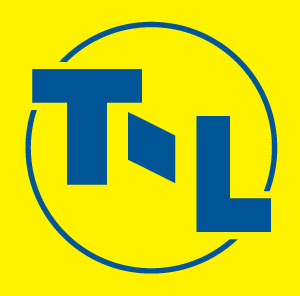
Contact:
808 Hwy 367 SouthTuckerman, AR 72473-0996
Office: 870-349-2644
Fax: 870-349-5326
Tommy Young - bestsprinkler@aol.com
